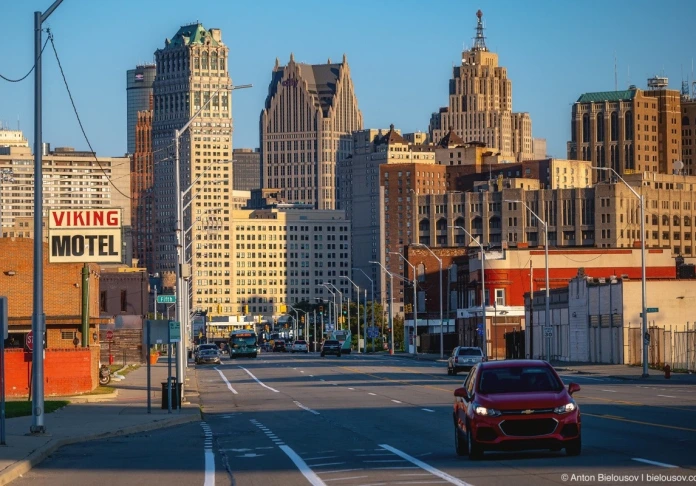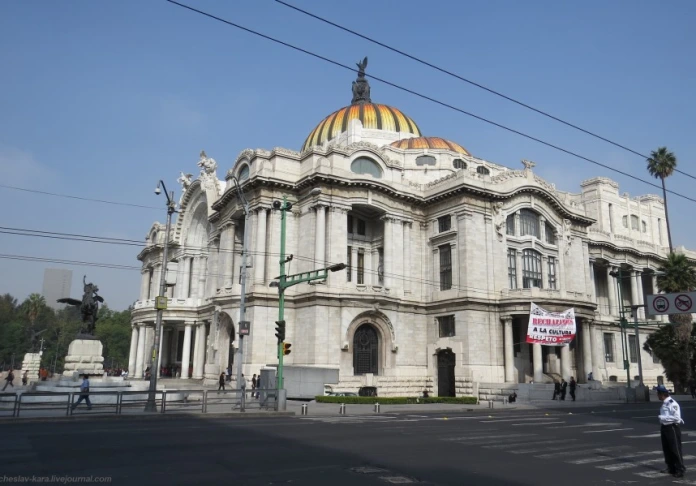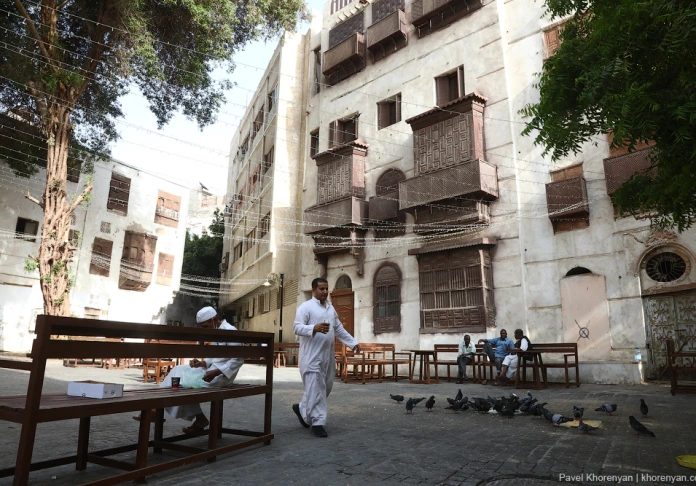Stockholm - City of the Future
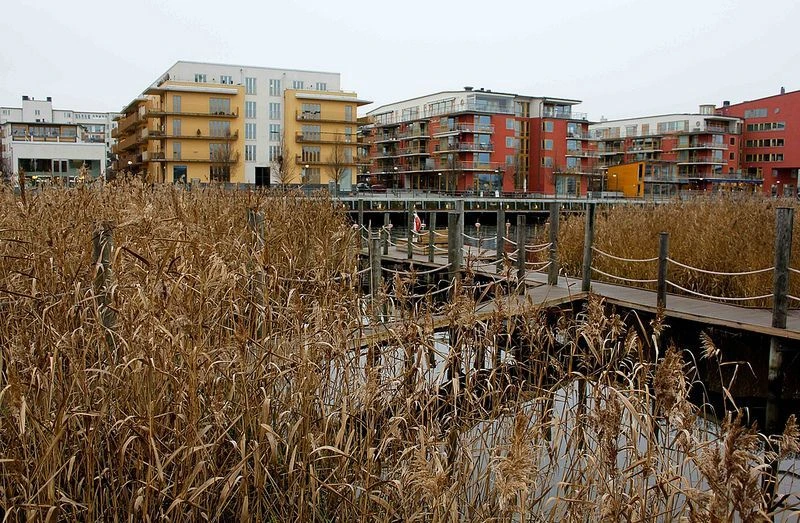
Swedish family, Swedish socialism and the Swedish side of the IKEA - here, perhaps, and all that he knows about the average citizen of Sweden. Capital - Stockholm, climate - north, and yes, allowed gay marriage. Meanwhile idyllic homeland Karlsson on the roof began in the early 21 th century one of the most successful countries in the world - Sweden has consistently ranked in the top five of most international rankings. The biggest GDP growth in the EU combined with the lowest carbon dioxide emissions in the developed countries and the maximum use of renewable energy - about 50% in the whole economy (average value in the world - 20%). It was in Sweden for the first time it has been proved impossible - the economy can grow while reducing emissions. The transition of society to "green" the rails visible everywhere - from design and architecture to the public utilities and transport. It is here that forged new technologies to be the solution to environmental and energy issues, and are run-solutions that become standard in other countries only through the years. The ideology of soulless West in Sweden found its maximum incarnation - Eternal Sunshine of the Spotless Mind and amaze technology. Energetically passive houses, quiet buses on biogas, self-cleaning bins in city parks, gas stations for electric vehicles and underground sewage treatment plants - we take a look behind the scenes of the machinery of Stockholm, the city where the future has already happened. Our tour will begin with the Hammarby Hёstad, which became the standard for residential construction in Northern Europe. Hammarby Hёstad
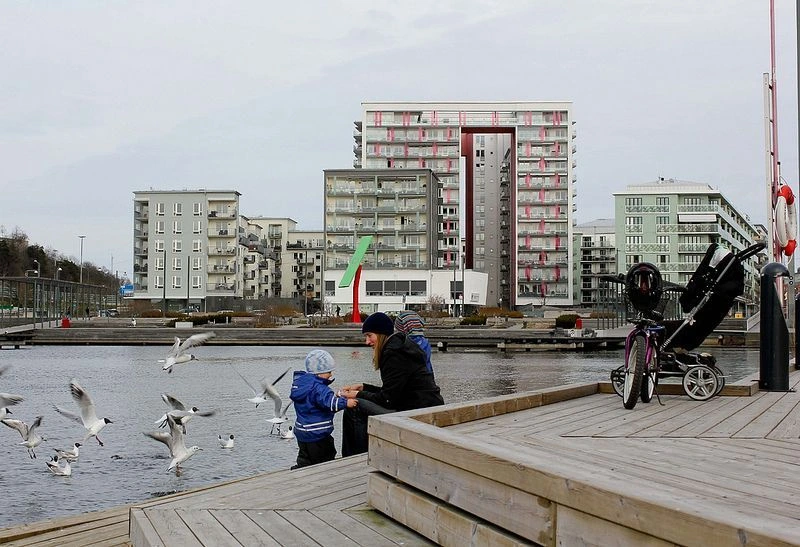
Employees of the municipality every morning spiked fortified bran for local waterfowl - that area was more alive. Therefore, there are gulls, ducks, swans, herons and even
only 15 years ago there was an abandoned industrial zone. Once upon a time there working weaving mills, and then there was an oil terminal. The old name of the district - Lyunet - became a household word to refer to the city sewers - albeit in a very soft Swedish understanding. The concept of Hammarby Hёstad a response planners and architects on the ideological impasse 90s. Evil Empire fell, the end of history, an advertisement Fukuyama took what to do next - it was not clear. A new concept of urban planning has become a utopia - ideal people in an ideal environment. To build a garden city - was once again the slogan designers, but it seems that this time they did it.
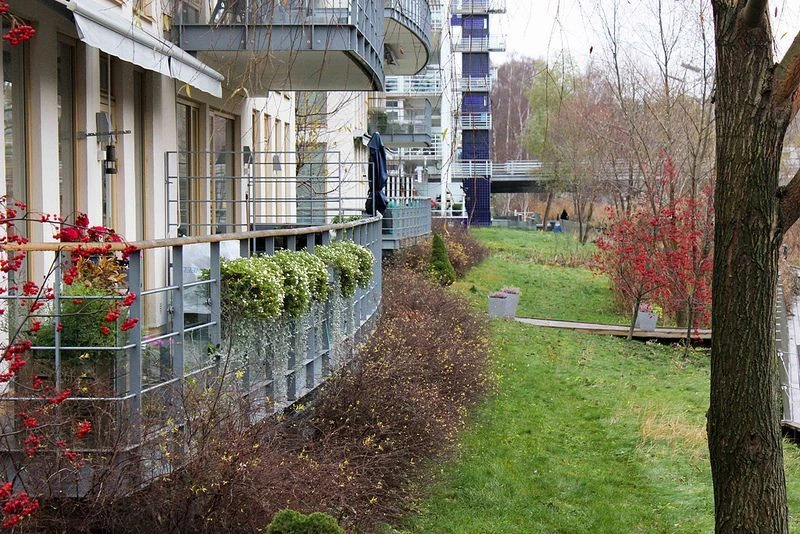
Now, 15 years after construction began, Hammarby Hёstad looks as if it was built yesterday. Pure forms of glass cubes, rising from the reeds planted landscape designers, winding paths on the footbridge across the creek and bays, artificial canals, wooden promenade with evening lights and your family with a brood swan swans - so the area looks to the casual passerby.
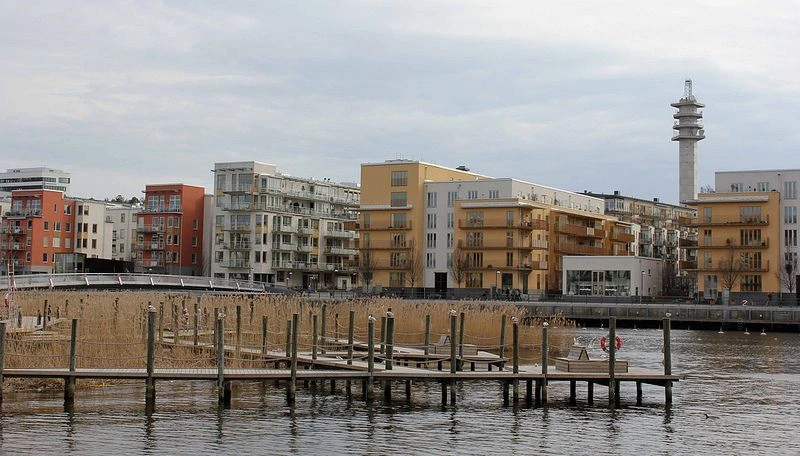
However, in an urban environment, all should be fine - not only exteriors, but also the inner content. The area was very expensive is due to the fact that for the first time in a pilot mode to use the technology, which later became more widely used. In particular, a recently known concept of "energy-passive houses". Under this meant building a home, ideally not Having commenced energy "outside", in principle, that is, it produces itself. Although it is 100 percent energy independent houses in the mass residential construction is not, in Hammarby Hёstad managed to get as close to the ideal. Approximation occurred in two ways: firstly, the construction of the innovative used insulating materials that help to minimize energy losses, and secondly, is producing energy at home. Heated people and household appliances air exits through the ventilation system enters the heat pump, which takes away the extra degrees, returning them to the heating system at home. On the roofs of solar panels - they cover the electricity consumption in the common areas: stairwells, garages, etc ..
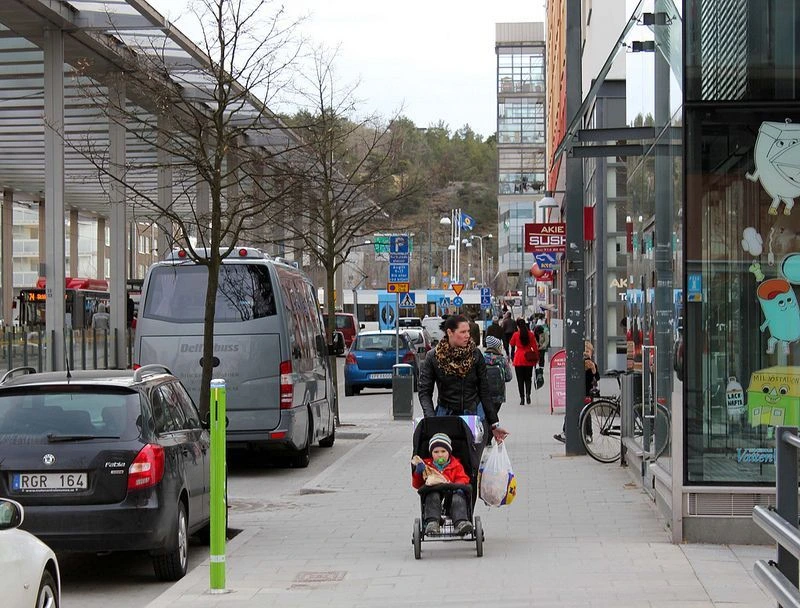
Green bar - filling for electric vehicles; left - the tram station
in front of the entrance porch is worth every screen that tells residents how much energy is produced panels on the roof of their house at the moment. Open terrace for picnics and barbecues on the roofs are covered with sod. Rainwater passing through it, cleaned and enters the system of technical water supply, and then re-used - for watering lawns or cooling heat pumps. Central vacuum sucks the garbage disposal bags with separately collected waste from the entire region into a special chamber - separate plastic, glass and metal separately.
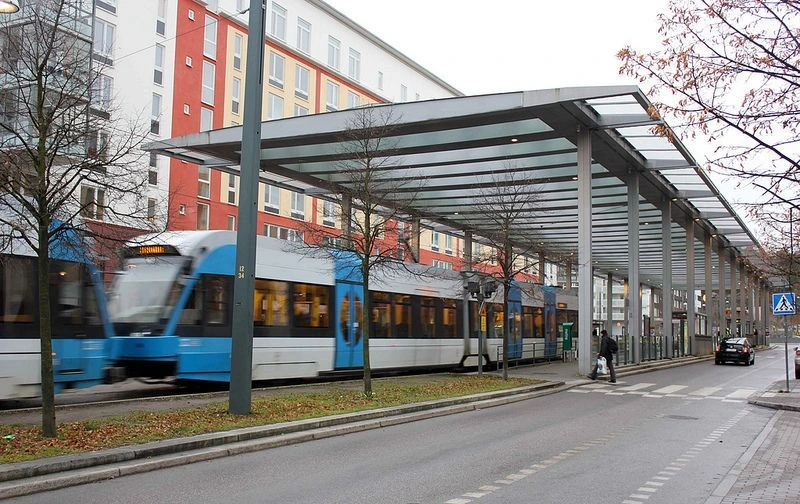
In floor trams is on par with the level of the platform. To facilitate the movement of disabled and prams by pressing the metal catwalk extends liquidating the gap between the platform and the floor of the car
enumeration of all innovation Hammarby Hёstad would probably take more than one page, so we will focus only on one more moment. The area is positioned as housing for young families with children, so the latter were given special attention. The architects have done without lurid colors children "towns" of pipes and swings, instead creating a system of games, blend in with the landscape and natural environment of the city. So, you can play the "classics", jumping on the rocks of granite, laid out on the bottom of the artificial stream. Or to the horror rock the casual tourist footbridge, specially suspended on springs of water.
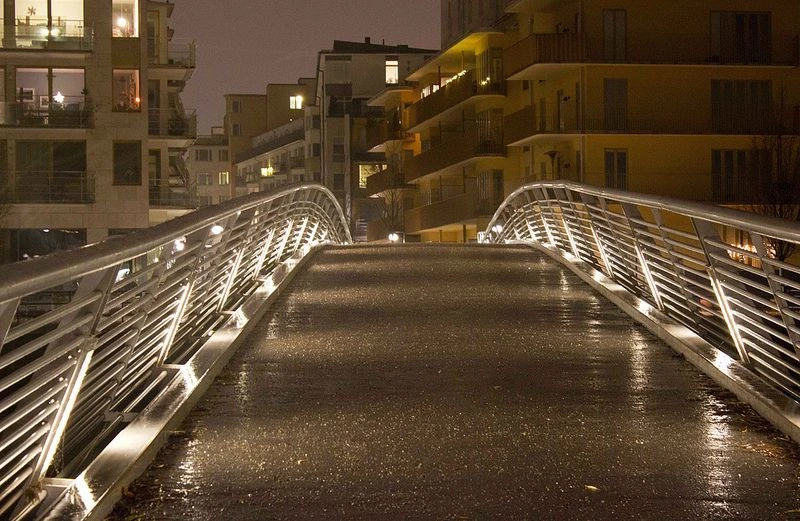
Once in the spring bridge Hammarby Hёstad, I want to stay here immediately and unconditionally, however, our way lies beyond - into the depths of the mountains Henriksdal where the sewage treatment plant in Stockholm. Looking Biogas from Hammarby Hёstad the rock massif, close, hard to believe that he really is almost empty: located in one of the largest sewage treatment plants in Europe. 300 thousand square meters of caves, 18 kilometers of tunnels, 150 thousand cubic meters of sewage water per day, elevation under a rock 70 meters - Henriksdalsverket as it is officially called, began to build in the 1930s.

Entry to the Henriksdalsverket
Another function of sewage treatment plants, besides the water purification is the production of biogas from sewage waste. Falls from the first stage with the water withdrawn by means of special machines and all solids were foreign objects. According to our attendant, "consumers are very creative when it comes to the sewer." Museum found in sewage treatment plants on things yet, but initial inspection of water still needed. Then the water is filtered by sand, which rammed and taken for use in construction, then there is its chemical removal of phosphorus and sewage water finally enters the pools for biological treatment. All that settles in the cleaning process, and collected at the first stage, is sent to the "rotten camera." There, at a certain temperature, the bacteria eats arrive and throughout his life produce methane or biogas.
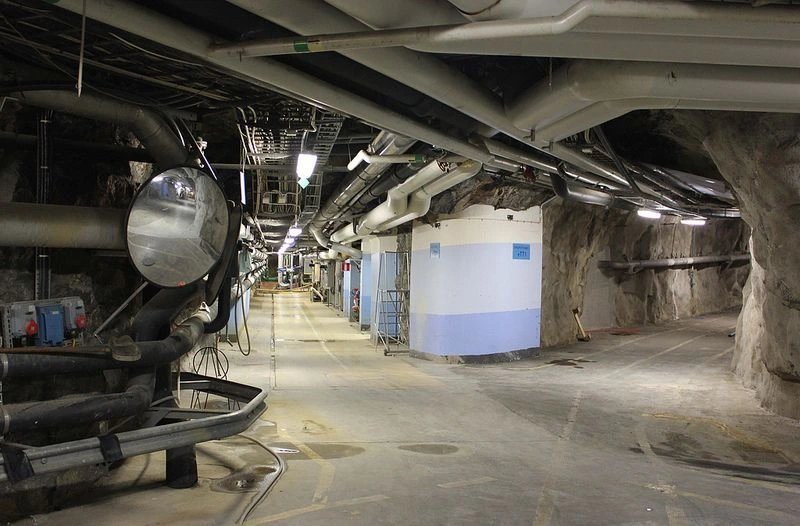
Run on biogas buses, cleaning equipment, many private cars. He also used some of CHP. Thanks to biogas and ethanol Sweden reduced oil consumption from 1990 by almost 40% - despite the fact that the fleet has grown. Are brought here as biological waste from large restaurants, and will soon begin collecting food waste from households. If you believe the PSAs prepared by the municipality on this issue, then the packet of potato peelings, more precisely, on biogas, which is made of it, a small car can travel 100 kilometers.
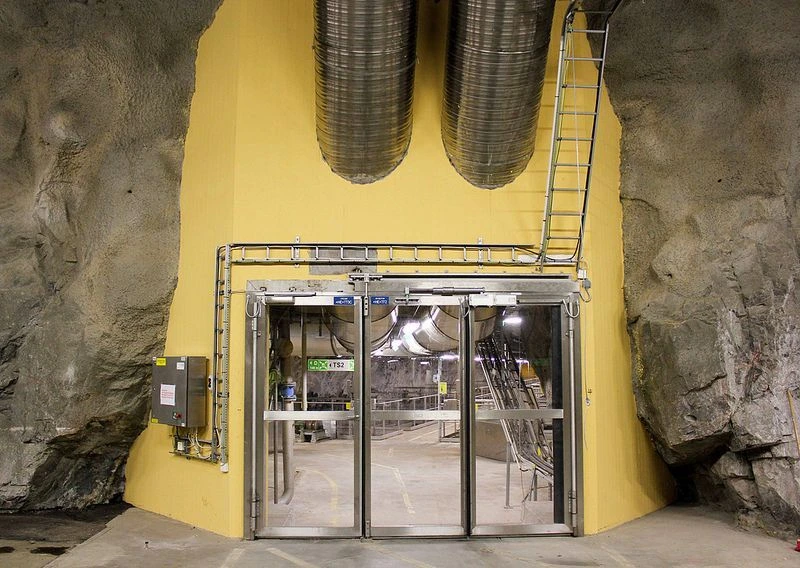
Airlock at the entrance to the chamber recycling of used oil and grease from restaurants - to the smell did not go out
after a cycle of biological treatment water passes through sand filters, where the particles are deposited last. Sewage water is warm enough through the processes occurring in it rotting. These free degrees are removed using heat pumps. The heat is used for heating treatment facilities themselves - otherwise such a large farm would consume enormous amounts of energy. At the final stage already peeled and chilled water is pumped through a giant funnel to a greater depth in the Baltic Sea.
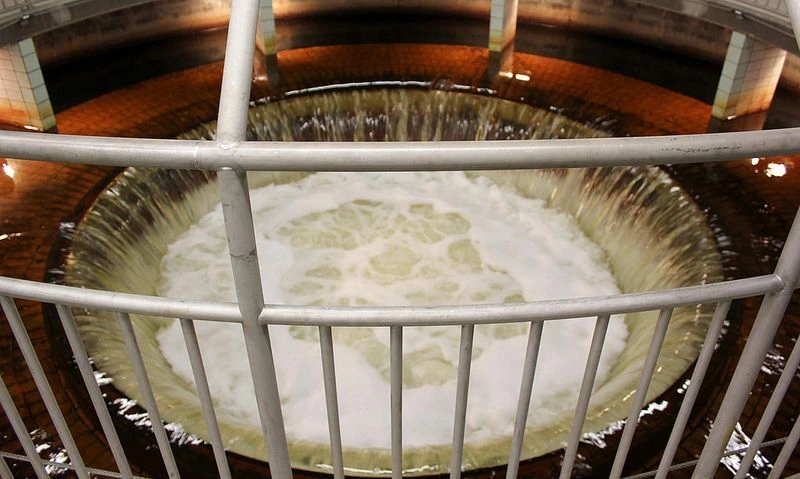
The diameter of the crater about 15 meters, purified water is pumped into the tube that runs along the bottom of the Baltic Sea. Through the holes of the pipe water gradually mixes with sea water. Thus done, that there was a constant flow of fresh strong and warmer water, which in this case affect the biosphere of this area of the sea
at the station practically no smell - the air goes through the ozone filter, cleaning it from a specific smell. The complex is constantly expanding and modernizing - have recently been built several caves for receiving and processing into biogas waste grease and oil from catering. In the future construction of additional filters that will clean the water from the residues of drugs and hormones. Passing through the human body and getting into drains, these chemicals are now partially bypass the cleaning and fall into the sea, leading to genetic mutations in fish.
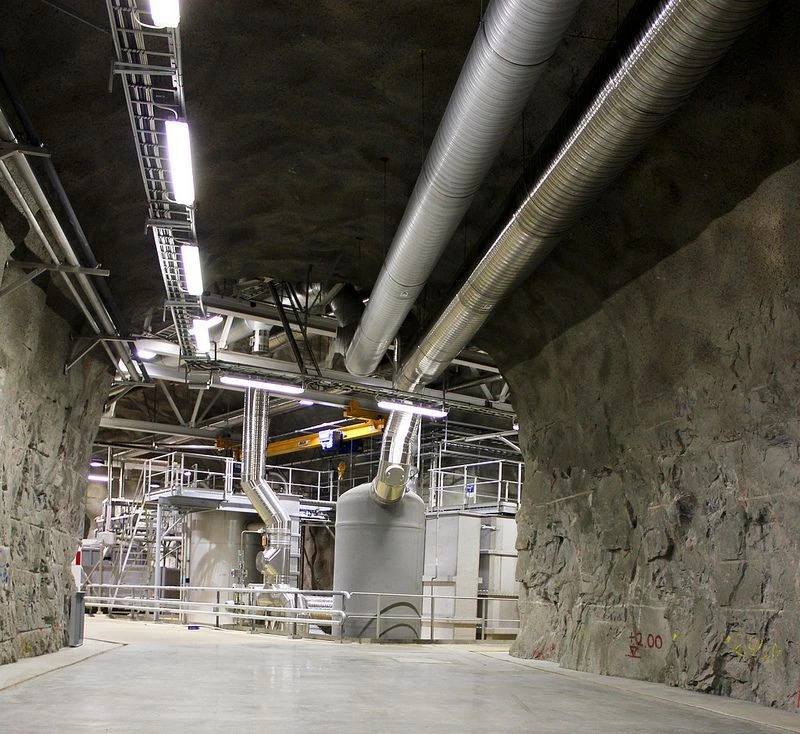
1.5-hour walk through the light-flooded dungeons filled with smooth hum of machinery, we met a couple of employees. Total work here, only 30 people who move through the tunnels on bicycles - at the entrance to the system is a service veloparkovki. At night, the station operates automatically without people. Even before the rise on the surface we encounter the thick black cat. "And this is the main worker!" - Laughing our guide - "Catch the Rats need at all times." Soon, however, it turns out that he joked, cat toy, and the rats in the tunnels is not ...
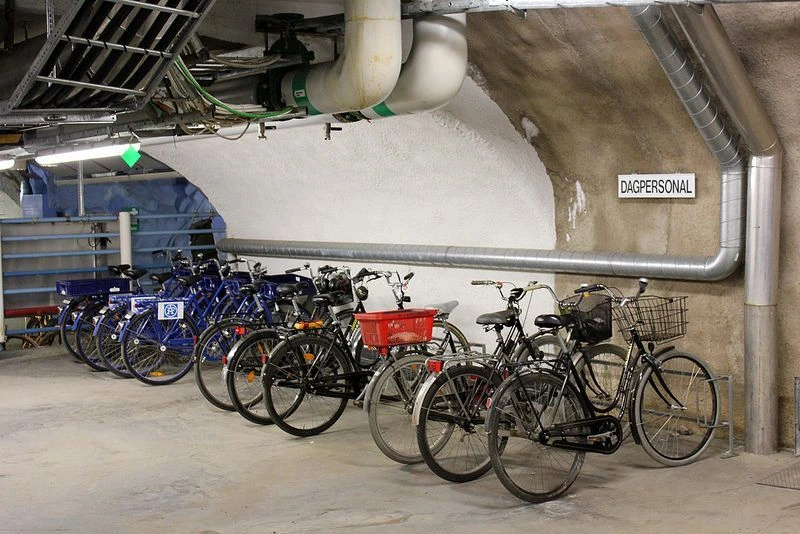
One of the consumers produced at wastewater treatment plants biogas is public transport in Stockholm - the pipe goes from the rock right in the bus depot Sёderhallen across the strait. Public transport When you first visit Stockholm surprised the cleanest air in the streets. One reason for this - the world's largest translation project of public transport on a renewable fuel. About 200 buses on biogas and 500 on ethanol travel through the Swedish capital. According to the plan of the municipal transport corporation SL by 2020, 100% of the bus fleet in the Stockholm region should work on renewable fuels - especially on biogas. Sёderhallen bus depot, which is one of the biogazoprovodov of Henriksdalsverket suddenly is on the roof of an office building in almost the city center. It is unlikely that the Swedes, engineering depot, inspired by stories of Astrid Lindgren. Rather, it had more weight to considerations of rationalizing the use of scarce urban space.
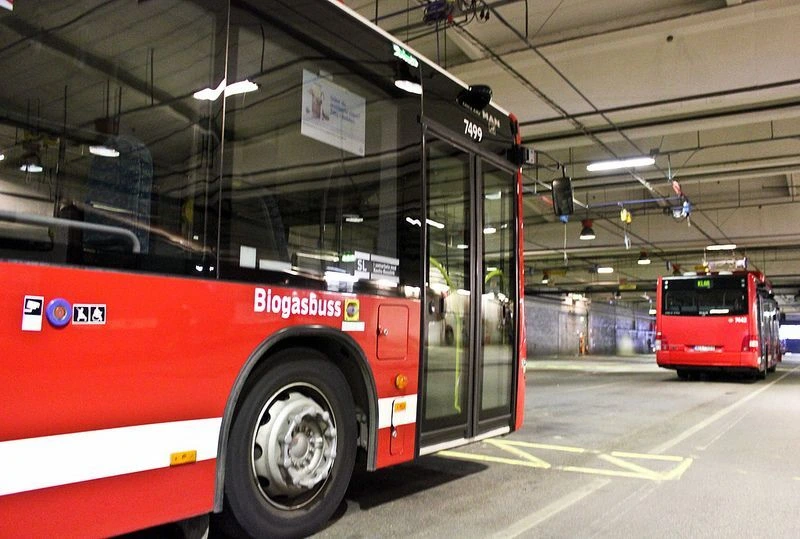
Virtually silent, comfortable, do not emit any harmful emissions or climate, biogas buses are a real nightmare for the operating company. Representative of the company Keolis, working in the depot, barely conceals annoyance - at the expense of a more complex maintenance and refueling buses on biogas companies are more expensive than traditional diesel 4.5 crowns per kilometer against 4 crown crown level (0.5 and 0.45 eur). Naturally, the carrier would be easier and cheaper to use an already proven technology, however, are conditions of the customer, the municipality - the annual percentage increase in the park environmentally friendly buses and reduce dependence on petroleum products.
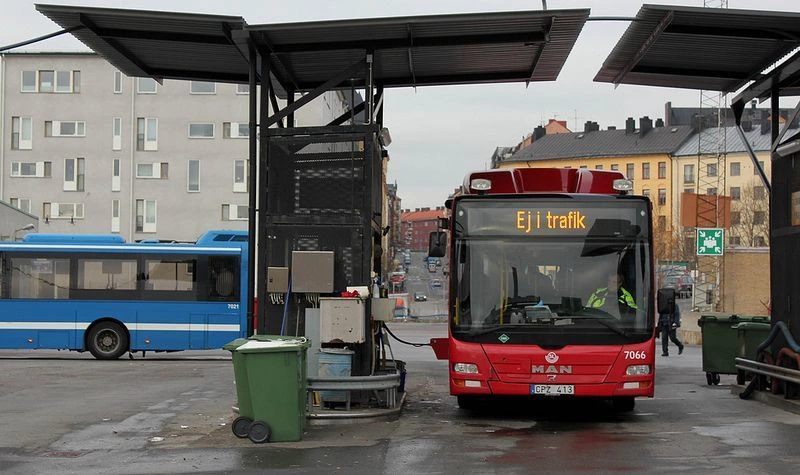
Filling biogas also occurs on the roof
While carriers may experience discomfort in the implementation of new principles of urban transport, society as a whole benefits from a more comfortable environment, clean air, reduce public spending on the treatment of respiratory diseases and - last but not least - the creation of special innovative environment in which the constant updates and progress occur even in conservative areas of life as a bus depot.
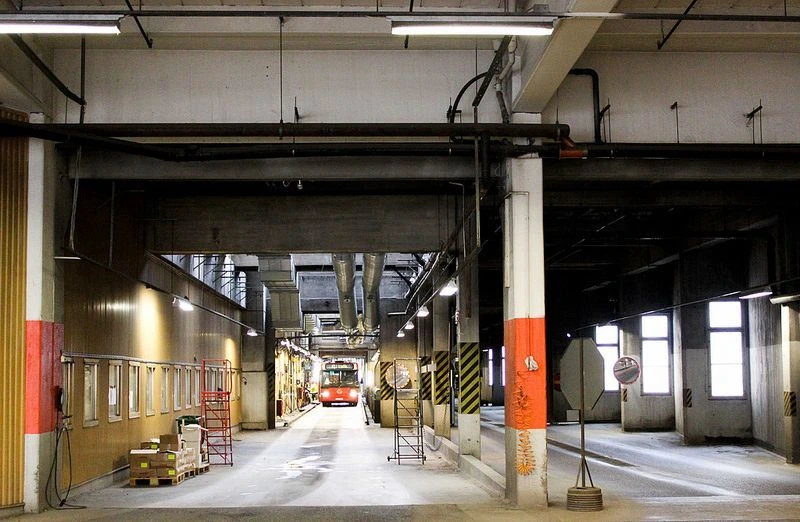
Depot inside
the most promising in terms of public transport is recognized as biogas, although more recently actively promoted ethanol, which is produced from rapeseed grown in including in Sweden itself. Otvyazka on oil and other fossil fuels - is a strategic goal of energy policy in Sweden. For this reason, the transition to alternative fuels is encouraged and rewarded: the most ordinary citizen who has acquired for the personal use of a car on biogas or ethanol, can count on a premium of up to 3 thousand euros, exemption from some taxes, cheap due to reduced fuel excise taxes, and even free parking in Stockholm. In connection with the prospect of massive electric vehicles, began to develop infrastructure and under them. Although it is in all of Sweden only about 500 electrical machines - mainly exhibition and test instances - in Stockholm already have about 100 elektrozapravok. Filling the future looks like a green bar with LED parking - three-phase connector allows you to "refuel" electric car for 30-40 minutes.
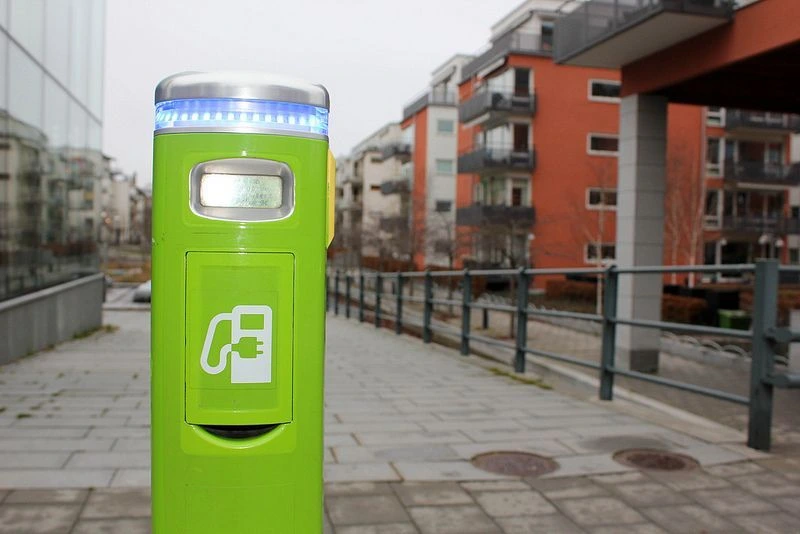
City of Stockholm has decided that at the beginning of line production of electric vehicles, the entire infrastructure in the city should be ready for it. Although it is seen primarily as an electric urban mode of transport, work in order to expand its range. Thus, the Government of Sweden and Norway have begun a joint project to adapt the route Stockholm-Oslo electric vehicles. The challenge for all of these efforts - the creation of an environmentally and economically sustainable society based on technology and closed energy cycle, when the energy is not burned forever, but simply moves from one state to another. The most important element of such a cycle is rubbish. Rubbish ever faster processing of natural resources in the trash was a major sign of the industrial economy. Still frames smoldering dumps to the horizon in third world countries are perhaps one of the strongest arguments against radical environmentalists scientific and technological progress and development of technology. Classical sorting garbage has been actively implemented in Sweden since the mid 70-ies of the last century. Now every Swedish family has 6-7 bins where - completely voluntary - distributed plastic, metal, paper, glass, cardboard, etc .. High level of consciousness achieved constant razyasnitelnoy work. Thus, the majority of Swedes know that from used plastic can make a new 7 times, after which he loses his property and is to be burned at the power plant, thus returning the energy expended in its creation, in the form of electricity. Due to the general household waste sorting landfill in Sweden disappeared as a phenomenon - garbage or reused, or is the fuel.
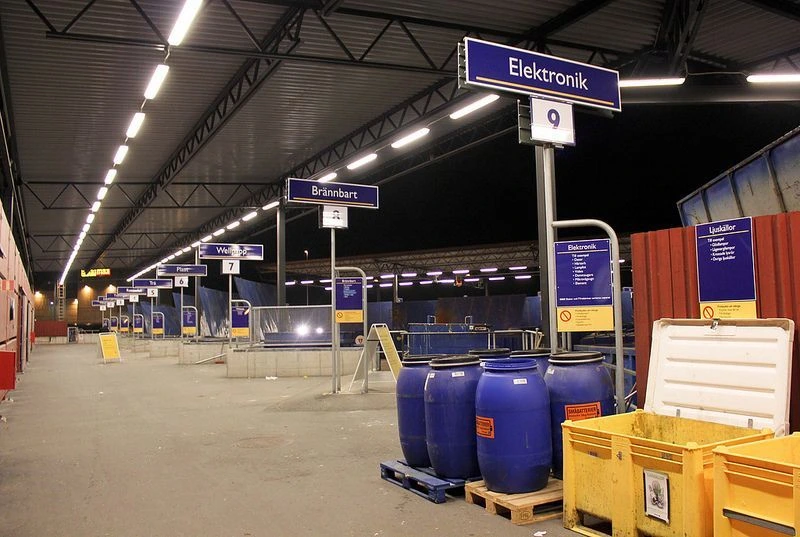
Station for receiving non-standard garbage based on the principle supermarket - a large parking lot in front, carts, "counters" to the names, where to put it: electronics, flammable materials, building materials, plastic, etc.
Over the same large objects - such as household appliances, furniture, building materials used, are brought to the special station where they are processed and disassembly for valuable components, which is paid by the taxpayers. They did it and returned in the form of raw materials, preparing to launch a new cycle of production. For processing paints, acids and other hazardous substances there is a separate system, which is the nodal point processing plant household chemicals. Such stations are open at convenient hours and completely free. New solutions are tested with respect to construction waste. So, now in Stockholm gradually demolished old office complex - special machines "bite" pieces of the building, which immediately go to the processing and construction of a new building on the same site. This process is called no demolition and deconstruction. Thus, the house that stood on this site before, will be essentially redesigned the new building. Rubbish same from urban boxes goes directly to the power plant. Technology of its collection also does not stand still - becoming more common central vacuum chutes. One of the last prime minister of the system took place in the square Mariyatoret in central Stockholm, where the popular park - a place for picnics and gatherings of young people in the summer. Despite the 3-time cleaning boxes, they were always overflowing garbage that was the cause of angry letters to the citizens in the municipality, - according to one survey, Stockholmers even rated their city as the dirtiest capital of Scandinavia. Now all 6 boxes connected by underground tubes extending into the central chamber. On the surface, visible only pipe ventilation shaft. Once the bin is filled, it sends a signal to the central chamber, which is under great pressure in the container is sucked rubbish. At a speed of 70 kilometers per hour arrives in trash container at the same time pressed together. When the filled container center, the signal goes to the control room, which sends the car to replace it.
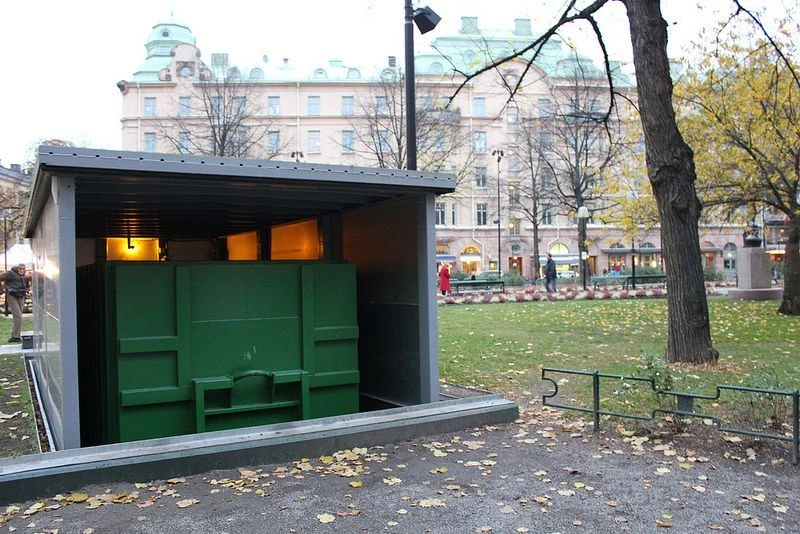
Replacement Fill the container
carried out for us a demonstration of the system was quite impressive - at the touch of a button on the remote control a piece of lawn suddenly began to rise, gradually pushing out the container. Under the ground is located a few technical facilities for servicing. Swedish company Envac, which developed this technology and manages 80 such systems only in Stockholm. The system is fully automatic, and management comes from a central control room via the Internet, ie, in fact only a few attendants ensure cleanliness in a large part of Stockholm. Although the initial investment in construction are very high, however in the long run, such systems are beneficial: now garbage container changes in average once a week, when previously it was necessary to empty bins 3 times a day . Advantages are obvious: lower fuel consumption (by the way, too, biogas) running on large machines, less staff time for unskilled work, less noise for residents of neighboring houses - and even in the height of the summer season urns. And in this case, the cumulative social benefits ultimately outweigh the direct economic effect. The above technologies are actively going for export, change and improve the lives of people in other countries. Small Scandinavian country makes its great contribution to the performance of duty "first" world to the "third" - helping and showing the direction. It seems that the very bright utopian future, promised once the authors of Soviet science fiction, after all, finally arrived. Let yet not everywhere. Special thanks to the company "Svea Tour", organized a visit to objects
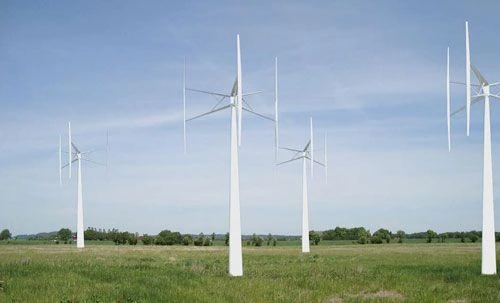
Experimental wind farms with vertical blades in Falkenberg - less noise, more effect


